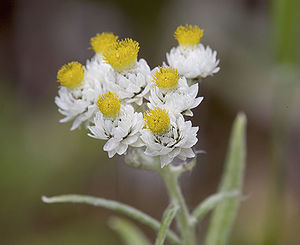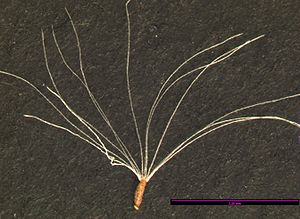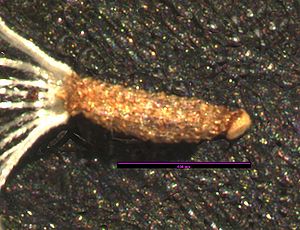Anaphalis margaritacea
Contents
Taxonomy
- Kingdom: Plantae
- (unranked): Angiosperms
- (unranked): Eudicots
- (unranked): Asterids
- Order: Asterales
- Family: Asteraceae
- Subfamily: Asteroideae
- Tribe: Gnaphalieae
- Genus: Anaphalis
- Species: A. margaritacea
Plant Description
Individual, erect, cottony stems grow 1-3 ft. tall and are often clumped together creating a bushy appearance. Narrow leaves are gray-green to woolly-white. Globular flowers are actually long-enduring, white, dry bracts arranged around a yellow center. Several evenly leafy woolly stems in a small patch are topped by a crowded, roundish cluster of flower heads with pearly-white bracts, sometimes with a dark spot at base of each outer bracts. The dried stalks with their pearly-white heads are attractive in floral arrangements. The pure white flower is commonly used in dried flower arrangements. Good dried flowers; food plant for Painted lady butterflies.
Bloom Period
July through September.
Distribution
Widely distributed throughout Washington; occurring throughout North America except for portions of Midwest and Southeast.
Habitat
Dry to somewhat moist open areas, low to sub-alpine elevations.
Uses
In folk medicine, it is used as a salve for burns. (Strickland)
Propagation
[Propagation protocol from USDA NRCS]
Seed
Abbreviation: ANMA
Seed sample from 2010
Average Measurement: 0.6 x 0.2 x 0.2
Measurement Range: L: 0.4 - 0.75, W: 0.1 - 0.3, D: 0.1 - 0.3
Features
Shape: Seeds somewhat ribbed. Right above hilum, seed narrows considerably before flaring out again.
Color: Seed is brown. Hilum is glossy and puckered, lighter colored that rest of seed.
Additional Features: Pappus of downy white hairs significantly longer that seed itself.
Surface: Seed covered in clear globules and is slightly lustrous.
Could be confused with: Antennaria howellii
Latitudinal Cross Section: elliptical ![]()
Longitudinal Cross Section: elliptical ![]()
Basic Explanations and Assumptions:
The dimensions for the seeds are length x width x depth. The location of the hilum is used as the base of the seed, and the length is measured from hilum to the opposite apex. Where a style is present, the length is measured from the hilum to the bottom of the style. Width is measured at a right angle to the length at the widest part. Depth is measured at a right angle to the intersection of height and width lines.
Measurements included are the mean average for each measurement of ten separate seeds.
All measurements in millimeters unless otherwise noted.



